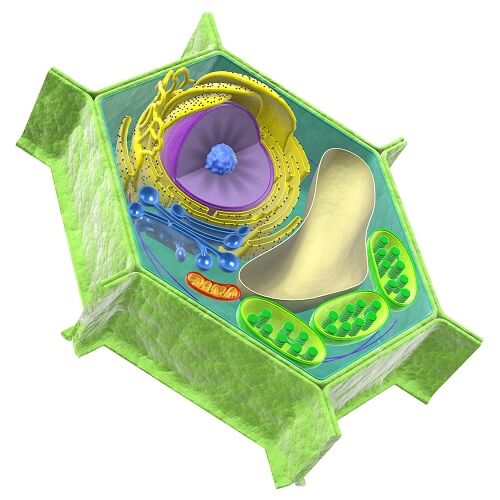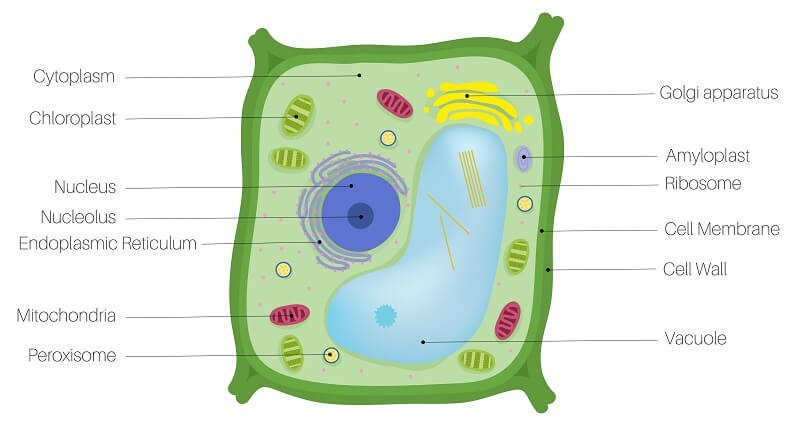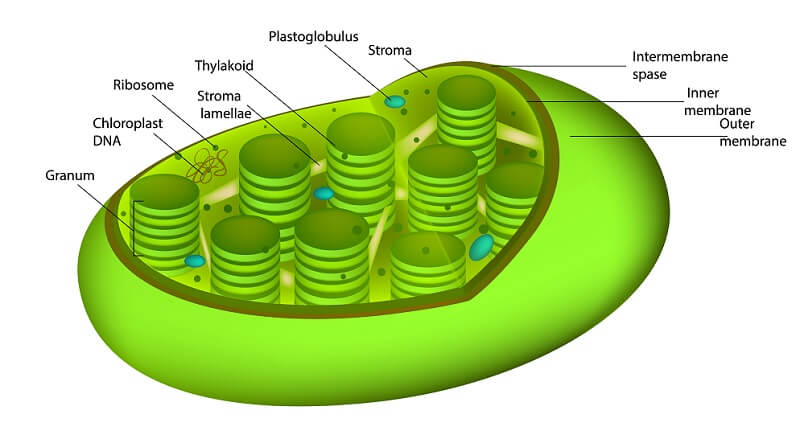Definition
Plant cells are the basic unit of life in organisms of the kingdom Plantae. They are eukaryotic cells, which have a true nucleus along with specialized structures called organelles that carry out different functions. Plant cells have special organelles called chloroplasts, which create sugars via photosynthesis. They also have a cell wall that provides structural support.

Overview of Plant Cells
Animals, fungi, and protists are made of at least one eukaryotic cell. In contrast, bacteria and archaea are made up of a single prokaryotic cell. Plant cells are differentiated from the cells of other organisms by their cell walls, chloroplasts, and central vacuole.
Chloroplasts are organelles that are crucial for plant cell function. These are the structures that carry out photosynthesis, using the energy from the sun to produce glucose. In doing so, the cells use carbon dioxide, and they release oxygen.
Other organisms, such as animals, rely on this oxygen and glucose to survive. Plants are considered autotrophic because they produce their own food and do not have to consume any other organisms. Specifically, plant cells are photoautotrophic because they use light energy from the sun to produce glucose. Organisms that eat plants and other animals are considered heterotrophic.
The other components of a plant cell, the cell wall, and central vacuole, work together to give the cell rigidity. The plant cell will store water in the central vacuole, which expands the vacuole into the sides of the cell. The cell wall then pushes against the walls of other cells, creating a force known as turgor pressure. While animals rely on a skeleton for structure, turgor pressure in plant cells allows plants to grow tall and reach more sunlight.
Plant Cells vs. Animal Cells
Plant and animal cells are both eukaryotic cells, meaning they possess a defined nucleus and membrane-bound organelles. They share many common features, such as a cell membrane, nucleus, mitochondria, Golgi apparatus, endoplasmic reticulum, ribosomes, and more.
However, they have some apparent differences. Firstly, plant cells have a cell wall that surrounds the cell membrane, whereas animal cells do not. Plant cells also possess two organelles that animal cells lack: chloroplasts and a large central vacuole.
These additional organelles allow plants to form an upright structure without the need for a skeleton (cell wall and central vacuole), and also allow them to produce their own food through photosynthesis (chloroplasts).
Parts of a Plant Cell

The plant cell has many different features that allow it to carry out its functions. Each of these structures, called organelles, carry out a specialized role.
Animal and plant cells share many common organelles, which you can find out more about by visiting the “Animal Cell” article. However, there are some specialized structures in plant cells, including chloroplasts, a large vacuole, and the cell wall.
Chloroplasts
Chloroplasts are specialized organelles found only in plants and some types of algae. These organelles carry out the process of photosynthesis, which turns water, carbon dioxide, and light energy into nutrients from which the plant can obtain energy. There can be over one hundred chloroplasts in certain plant cells.
Chloroplasts are disk-shaped organelles that are surrounded by a double membrane. The outer membrane forms the external surface of the chloroplast and is relatively permeable to small molecules, allowing substances entry into the organelle. The inner membrane lies just beneath the outer membrane and is less permeable to external substances.
Between the outer and inner membrane is a thin intermembrane space that is about 10-20 nanometers wide. The center of the chloroplast that is enclosed by the double membrane is a fluid matrix called the stroma (you can think of this like the cytoplasm of the chloroplast).
Within the stroma, there are many structures called thylakoids, which look like flattened disks. Thylakoids are stacked on top of one another in vascular plants in stacks called grand. Thylakoids have a high concentration of chlorophyll and carotenoids, which are pigments that capture light energy from the sun. The molecule chlorophyll is also what gives plants their green color.

Vacuoles
Plant cells are unique in that they have a large central vacuole. A vacuole is a small sphere of plasma membrane within the cell that can contain fluid, ions, and other molecules. Vacuoles are essentially just large vesicles. They can be found in the cells of many different organisms. However, plant cells characteristically have a large vacuole that can take up anywhere from 30% to as much as 90% of the total cell volume.
The central vacuole of a plant cell helps maintain its turgor pressure, which is the pressure of the contents of the cell pushing against the cell wall. A plant thrives best when its cells have high turgidity, and this occurs when the central vacuole is full of water. If turgor pressure in the plants decreases, the plants begin to wilt. Plant cells fare best in hypotonic solutions, where there is more water in the environment than in the cell. Under these conditions, water rushes into the cell by osmosis, and turgidity is high.
Animal cells, in comparison, can lyse if too much water rushes in; they fare better in isotonic solutions, where the concentration of solutes in the cell and in the environment is equal, and the net movement of water in and out of the cell is the same.
Many animal cells also have vacuoles, but these are much smaller and tend to play a less crucial function.
Cell Wall
The cell wall is a tough layer found on the outside of the plant cell that gives it strength and also maintains high turgidity. In plants, the cell wall contains mainly cellulose, along with other molecules like hemicellulose, pectin, and lignins. The composition of the plant cell wall differentiates it from the cell walls of other organisms.
For example, fungi cell walls contain chitin, and bacterial cell walls contain peptidoglycan. These substances are not found in plants. Importantly, the main difference between plant and animal cells is that plant cells have a cell wall, while animal cells do not.
Plant cells have a primary cell wall, which is a flexible layer formed on the outside of a growing plant cell. Plants can also have a secondary cell wall, a tough, thick layer formed inside the primary plant cell wall when the cell is mature.
Other Organelles
Plant cells have many other organelles that are essentially the same as organelles in other types of eukaryotic cells, such as animal cells.
- The nucleus contains deoxyribonucleic acid (DNA), the cell’s genetic material. DNA contains instructions for making proteins, which controls all of the body’s activities. The nucleus also regulates the growth and division of the cell.
- Proteins are synthesized in ribosomes, modified in the endoplasmic reticulum, and folded, sorted, and packaged into vesicles in the Golgi apparatus.
- Mitochondria are also found in plant cells. They produce ATP through cellular respiration. Photosynthesis in the chloroplasts provides the nutrients that mitochondria break down for use in cellular respiration. Interestingly, both chloroplasts and mitochondria are thought to have formed from bacteria being engulfed by other cells in an endosymbiotic (mutually beneficial) relationship, and they did so independently of each other.
- The liquid within the cells is the cytosol. It is mostly made of water, and also contains ions, proteins, and small molecules. Cytosol and all the organelles within it, except for the nucleus, are called the cytoplasm.
- The cytoskeleton is a network of filaments and tubules found throughout the cytoplasm of the cell. It has many functions; it gives the cell shape, provides strength, stabilizes tissues, anchors organelles within the cell, and has a role in cell signaling. The cell membrane, a double phospholipid layer, surrounds the entire cell.
Plant Cell Types
There are five types of tissue formed by plant cells, each with different functions. Parenchyma, collenchyma, and sclerenchyma are all simple plant tissues, meaning they contain a single cell type. In contrast, xylem and phloem contain a mixture of cell types and are referred to as complex tissues.

- Parenchyma tissue represents the majority of cells in a plant. They are found in leaves and carry out photosynthesis and cellular respiration, along with other metabolic processes. They also store substances like starches and proteins and have a role in plant wound repair.
- Collenchyma tissue provides support to growing parts of a plant. They are elongated, have thick cell walls, and can grow and change shape as a plant grows.
- Sclerenchyma tissue contains hard cells that are the main supporting cells in the areas of a plant that have ceased growing. Sclerenchyma cells are dead and have very thick cell walls.
- Xylem cells transport mostly water and a few nutrients throughout a plant, from the roots to the stem and leaves.
- Phloem cells transport nutrients made during photosynthesis to all parts of a plant. They transport sap, which is a watery solution high in sugars.
Quiz
